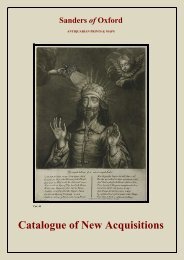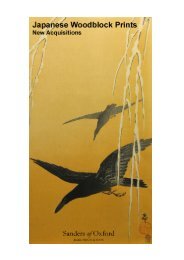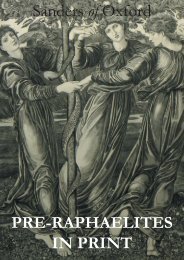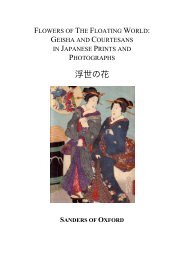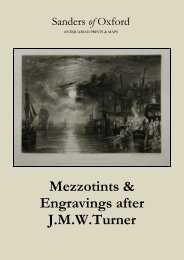catalogue text.indd - Sanders of Oxford
catalogue text.indd - Sanders of Oxford
catalogue text.indd - Sanders of Oxford
You also want an ePaper? Increase the reach of your titles
YUMPU automatically turns print PDFs into web optimized ePapers that Google loves.
centuries. The Kirkwood family engraved banknotes and manufactured globes in addition to the production <strong>of</strong> maps<br />
and the printing <strong>of</strong> illustrations. Both William Johnston and Alexander Keith Johnston were employed by the Kirkwood<br />
family before starting their own successful firm W. & A. K. Johnston.<br />
David Lucas (1802 - 1881) was a British printmaker who specialised in mezzotint. He was a pupil <strong>of</strong> Samuel William<br />
Reynolds, and worked from Bryanston Square, London, upon the completion <strong>of</strong> his education. He produced prints<br />
after Gainsborough, Vernet, Isabey and Hoppner amongst others, but it was his works after Constable that earned him<br />
true renown. The collaboration between the pair was one <strong>of</strong> the most successful in the history <strong>of</strong> British printmaking.<br />
Whilst Turner amassed a group <strong>of</strong> faithful engravers to whom he would turn, Constable virtually employed only<br />
Lucas, and this fidelity was repaid by the stunning translation his work received from 1829, until long after his death<br />
in 1837.<br />
Samuel Palmer (1805 – 1881) was a visonary artist and contemporary <strong>of</strong> William Blake. A key figure in British Romanticism<br />
he was also a prolific writer as well as a watercolourist, etcher and printmaker. Palmer is best known for his<br />
early works executed at Shoreham where he lived between 1826 to 1835. Introduced to William Blake by John Linnel<br />
(whose daughter he would later marry) Palmer and artists George Richmond and Edward Calvert formed a group<br />
named The Ancients who were charicterised by their admiration for the work <strong>of</strong> William Blake and their attraction to<br />
archaism in art.<br />
Like many great artists, it was not until after death that the works <strong>of</strong> Samuel Palmer were rediscovered and finally afforded<br />
the attention they deserved. Although his watercolours were popular in England at the time, Palmer struggled<br />
financially throughout his life time and had to divert much <strong>of</strong> his attentions to teaching to support himself and his<br />
wife, Hannah Linnel. After his death in 1881, Samuel Palmer was largely forgotten, his surviving son, Alfred Herbert<br />
Palmer, even went as far as to burn a large portion <strong>of</strong> his fathers work in 1901, stating that: “Knowing that no one<br />
would be able to make head or tail <strong>of</strong> what I burnt; I wished to save it from a more humiliating fate”.<br />
In 1926 Martin Hardie curated a show at the Victoria and Albert Museum entitled Drawings, Etchings and Woodcuts<br />
made by Samuel Palmer and other Disciples <strong>of</strong> William Blake. This kick-started the revival <strong>of</strong> interest in Palmers<br />
work which subsequent retrospective exhibtions and publications have continuously reinforced thoughout out the rest<br />
<strong>of</strong> the 20th century. The Shoreham work in particular has had a noteable influence on several important 20th century<br />
artists such as Frederick Landseer Griggs, Robin Tanner, Graham Sutherland, Paul Drury and Eric Ravilious.<br />
Simon François Ravenet I (1706 - 1774) was a French engraver and publisher. He was born in Paris, where he studied<br />
engraving under Jacques-Philippe Le Bas. Ravenet began engraving Jean-Baptiste Massé’s ‘Grande Galerie de<br />
Versailles’ in 1731, and was still labouring on the commission when in 1743, he was brought to London by William<br />
Hogarth to work on the ‘Marriage à la Mode’ series. He then remained in Britain for the rest <strong>of</strong> his career where he<br />
made additional prints for Hogarth such as ‘The Good Samaritan,’ and the ‘Pool <strong>of</strong> Bethesda’. He was also employed<br />
by John Boydell, and engraved his ‘Collection <strong>of</strong> Prints from the most Capital Paintings in England’ between the years<br />
<strong>of</strong> 1763-72. Ravenet, together with F. Vivares, and V. M. Picot, was instrumental in the revival <strong>of</strong> engraving in England,<br />
and founded an important school for the form in London.<br />
Alfred Rethel (1816 - 1859). Rethel was a designer <strong>of</strong> woodcuts and etchings. Born in Diepenbend, 1816, he begun<br />
his studies in Aachen with Bastinés. He went on to train in Düsseldorf under Schadow (1829-36) and Frankfurt on the<br />
Main. From 1844-5 and again in 1852-3 he travelled and worked in Italy. It is believed he went insane in 1853.<br />
Archibald Robertson (1765 - 1835) was a British landscape painter and aquatinter. He is sometimes referred to as<br />
Lieutenant-General, and though he is known to have painted naval scenes, he himself never served in the forces.<br />
Robertson has also been identified with the moniker ‘Archibald Macduff’, which appears in the prints after James<br />
Barry, though this is once again tenuous, and some critics believe it to have been a pseudonym for Barry instead. What<br />
is known is that shortly after the publication <strong>of</strong> his Scottish views, Robertson emmigrated to America, wherein he<br />
opened the Columbian Academy <strong>of</strong> Painting with the help <strong>of</strong> his brother Alexander. He also made a career in painting<br />
miniature portraits upon ivory, and several <strong>of</strong> these are in the collection <strong>of</strong> the Metropolitan Museum <strong>of</strong> Art.<br />
Gérard Jean Baptiste Scotin II (1698 - 1755) was a French engraver. Scotin II began his career in Paris, and engraved<br />
several works after Antoine Watteau around the year <strong>of</strong> 1725. Together with his brother, Louis Gérard, he emmigrated<br />
to London in 1733, and remained their for the entirety <strong>of</strong> his career. During this time he produced prints after Francis<br />
Hayman for Tobias Smollett’s Edition <strong>of</strong> Cervantes ‘Don Quixote.’ He also engravinged the plates for Hogarth’s ‘Marriage-à-la-Mode’<br />
series in 1745.




